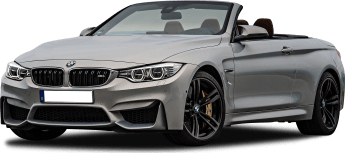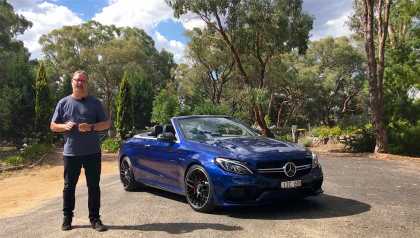BMW continues to expand its range of hot-to-trot sedans and coupes, with the company adding three new variants across its M3 and M4 ranges.
At one end is the Pure, a stripped-down version of the regular M3 and M4, while at the other is the new M4 CS, which is designed to appease potential buyers who may have missed out on the potent but limited – and expensive – M4 GTS.
We had a brief drive in both variants in Victoria, and it’s clear that one variant is a lot better than the other. And not necessarily the one you might think…
BMW M4 2017:
| Engine Type | Turbo 6, 3.0L |
|---|---|
| Fuel Type | Premium Unleaded Petrol |
| Fuel Efficiency | 8.3L/100km (combined) |
| Seating | 4 |
| Price From | $48,400 - $55,660 |
Is there anything interesting about its design?
8 / 10
The M4 Pure looks all but identical to the M4 (and M4 Competition, if I’m honest), with the only real difference in aesthetics coming from the rim size and style.

All three feature an M bodykit that adds aggression and punch over a regular 4 Series, while the bulgy bonnet, quad exhausts and gloss black grille also tells people it’s no ordinary Bimmer.
The CS does step the game forward, with a bespoke front splitter in carbon fibre as well as a subtle rear end revision that includes the rear diffuser from the GTS under the bumper, and a small spoiler on the bootlid.
How practical is the space inside?
7 / 10
The Pure’s front half makes for a comfortable and familiar location, especially if you’ve sat in a BMW over the last few years. It’s less ostentatious than the other M4s, too, with simple yet attractive cloth fabric, a leather-wrapped wheel and a restrained trim palette.
The CS steps things up a few notches, with literally metres of motorsport-spec Alacantara suede covering the inside, including the steering wheel. Our experience shows that suede wheels can wear more quickly with use, but they can be easily re-covered when the need arises.

The M-Sport front seats, too, are much more aggressive and sporty, but are still a decent fit even for the, erm, larger gentleman.
Both cockpits sling the driver’s seat low, and the steering wheel can be brought in close, making for an inclusive driving feel.
The two-door M4’s rear-seat area isn’t a focus for most buyers, but it is surprisingly difficult to access. There is a rear-mounted electric slider switch, but the seat-back latch is difficult to both grab and operate, and the seat moves forward very slowly. The high sill, too, makes rear access a tough task.
There are two ISOFIX points if you do want to bring kids along (good luck getting them in), and the seats drop down to extend the 445-litre luggage area.
There’s also space for two bottles front and rear in the Pure, a smallish stash space below the centre console and a lidded bin with a (kinda outdated) modular phone holder that requires the purchase of a bespoke bracket to suit your phone.

The CS must do without the bin, while its lightweight compressed-fibre door skins also forgo pockets and bottle holders. The door handles are also replaced with poorly placed racecar-spec fabric door pulls that make it quite an effort to actually close the door. Fashion over function of the highest order here (are you really saving that much weight over a door handle?).
There’s no spare wheel in either car, with a can of sealant and BMW’s Concierge services your only respite in case of a flat.

Does it represent good value for the price? What features does it come with?
8 / 10
We drove the M4s during the launch event, so we’ll concentrate on those – suffice to say the M3 is all but identical save for its extra two doors and its cheaper price point. Because sometimes, more is less.
The $129,900 M4 Pure is unique to Australia, and is based on the regular $139,900 M4. It’s still pretty well equipped, too, despite its bargain-basement assignation.

It still gets a 317kW twin-turbo six-cylinder engine, rear-wheel drive and a seven-speed dual clutch gearbox (with a sweet six-speed manual as a no-cost option).
It also gets everything you’d expect in a Bimmer, including a carbon fibre reinforced plastic (or CFRP) roof, to lower the centre of gravity as well as looking sexy, automatic lights and wipers, head-up display, digital radio, powered seats, pushbutton start, a nine-speaker stereo and an updated iDrive multimedia system run from on an 8.8-inch touchscreen.
Four-piston front and two-piston rear brakes, adaptive suspension and a limited slip rear diff are also included.
The new CS, which costs $211,610 plus on roads, is about $82,000 more than the Pure.
It misses out on a full leather interior, the rims are only 19 inches in diameter front and back instead of 20, and the headlights are merely LED, not adaptive. I don’t know about you, but they’re all things I can live without…
At the top is the new CS, which costs $211,610 plus on roads – or about $82,000 more than the Pure, and a $56,000-odd jump from the $154,900, 331kW M4 Competition, upon which it's based.
For that you get more stick – outputs jump to 338kW and a GTS-matching 600Nm – as well as set of staggered-size wheels. The rears are 20 inches in diameter fitted with 265mm wide tyres, while the 19s up front are shod in 285mm-wide Michelin Cup Sport 2 tyres – the same set-up as the GTS, incidentally.

There’s also a 25 per cent lighter CFRP bonnet, carbon fibre front splitter and a GTS-spec rear diffuser, along with lighter M-Sport front seats and lashings of motorsport-spec Alcantara suede in the cabin.
Interestingly, it does – finally – give the M range a car that outpoints its arch rival, the 336kW/600Nm Mercedes-AMG C63 in outputs, although it’s still more expensive.
What are the key stats for the engine and transmission?
8 / 10
A new exhaust backbox, an ECU tweak and an extra dollop of revs to the 3.0-litre twin-turbocharged straight-six petrol engine nets the CS an extra 7kW of power over the Competition to push it out to 338kW at 6200rpm with a 7600rpm redline, and yields 50Nm more torque for 600Nm across a much narrower range of 4000-5380rpm.
The 0-100km/h dash for the CS is exactly 0.1 of a second quicker than the Competition at 3.9 seconds.

The Pure, meanwhile, makes 317kW at 5500rpm and 550Nm between 1850 and 5000rpm. It’ll do 0-100km/h in 4.1 sec in dual-clutch guise.
The lighter bonnet only gives the 1580kg CS a 5kg weight advantage over the Pure in dual-clutch spec, while the manual Pure is 20kg lighter than the CS, which can’t be had in self-shifter guise.
How much fuel does it consume?
8 / 10
Interestingly, the more powerful CS claims a better combined fuel economy figure of 8.4 litres per 100km than the Pure, which returns a claimed 8.8L/100km on the combined cycle.
A 100km dash in the Pure netted us a dash-indicated figure of 9.1L/100km, while our CS test was a bit too short (and too track focused!) to effectively verify BMW’s claim.
What's it like to drive?
7 / 10
Both the Pure and the CS rely on BMW’s tri-mode adaptive dampers to give the car a different character when required, as well as an ‘All Ahead Full’ M button that can be set to a driver’s preference for throttle, gearbox, damper and steering modes.
Through town and out on the freeway, the M4 is pleasant enough in comfort mode, with a bit of tyre roar making its way into the car on rougher surfaces.

The Pure’s 19-inch wheels wear slightly taller-profile, less-aggressive tyres than the CS, which, combined with its lower engine output, gives the cheaper car a surprisingly more mellow demeanor overall. It’s not soft, mind you; it’s still pushing almost 500 old-school horsepower to the rear tyres, so there’s plenty on tap if you want to play.
Like the Competition, the CS shows a more mature side once the pace increases. The stiffer springs from the Competition and the more aggressive tyre set combine to reveal a complex damper map that can handle mid-corner corrugations and bigger hits with aplomb, while the chunky brakes are superbly modulated and offer incredible feel all the way through a big stop.
Both M4s come together beautifully on longer runs, with especially seamless flow through faster, longer corners. Ultimately, the M4 likes to be leant on a bit - but it takes a deep breath to trust it implicitly.
The steering, too, is still too digital and artificial at crucial moments. It turns in with aplomb and holds a line, but you’re not feeling it through your fingertips when you need it most, despite an array of electronic feels to pick from. Older M cars were far better in this area.
A few track laps confirms that the M4 is still a terrific toy, and that lack of linearity in the throttle map and steering don’t overly hurt its pace.
Warranty & Safety Rating
What safety equipment is fitted? What safety rating?
7 / 10
Full-length curtain, front and front-side airbags, as well as plenty of high-stregth steels in the body build, help to give the BMW a top ANCAP score of five stars.
BMW doesn’t offer a ‘full stop’ automatic emergency braking function, stating that it wants the driver to still have final control over an emergency stop. The M4 also misses out on lane guidance and adaptive cruise control.
It offers a ‘light’ city-braking option, along with lane-departure warning, pre-emptive safety preparation and an intelligent emergency call function that activates in the event of a crash.
What does it cost to own? What warranty is offered?
8 / 10
BMW also offers a Service Inclusive program for $3533, which covers everything – including spark plugs, brake fluids and other liquids – for five years or 80,000 km.
A more inclusive program that includes brake rotors, pads and clutch plates costs $8195.
A three-year free roadside service assistance program also covers the range.
Verdict
The CS is a rocketship, no doubt, and it looks pretty incredible up close. Honestly, though, I’m struggling to see the value in an $82,000 leap from the Pure.
Factor in more expensive tyres – and different sizes at each end! – and little things like less robust interior trim, and the Pure starts to look like very good buying.
If you missed out on the GTS, the CS is a good substitute. If you’re looking for a BMW M4 that offers most of the bang for far fewer bucks, then the Pure is for you.
Would you go for the BMW M4 CS or the Pure?
Pricing Guides







.jpg)









.jpg)

.jpg)

